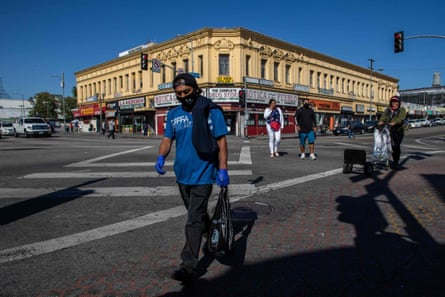The average number of Latino residents dying from coronavirus each day in Los Angeles county has increased by more than 1,000% since November, according to county public health officials.
Los Angeles is battling one of the worst Covid-19 outbreaks in the US, amid a winter surge that has left hospitals across the region overwhelmed. LA county’s Latino population has faced the brunt of the crisis.
In November, the average number of Latino residents in LA county dying from Covid-19 each day stood at 3.5 per 100,000 residents. Now, it is 40 deaths per 100,000 residents. “That’s an increase of over 1,000%,” said Barbara Ferrer, the county public health director at a briefing this week.
“Los Angeles under Covid-19 has won the world series in baseball, the championship in basketball and holds the title for most Covid-19 infections and the most Latinos who are losing their lives,” said Sonja Diaz, the founding director of the Latino Policy and Politics Initiative at the University of California, Los Angeles, to the Guardian.
Los Angeles county’s population is 48.6% Latino, but Latinos are dying at a rate of more than one-and-a-half times that of all Los Angeles residents. As of this week, 231 Latinos died per 100,000 people in Los Angeles county, according to county data, as compared to 82 white people per 100,000. “Our Latinx community is, in fact, bearing the worst of this pandemic,” said Ferrer.
It’s a devastating trend that’s reflected in other parts of the state as well. Latinos represent 38.9% of California’s population, yet constitute 55% of positive Covid-19 cases and nearly half the deaths.
Diaz pointed out this is because Latinos make up much of the essential workforce and are often forced between risking exposure to the virus and earning a paycheck.

“Nationally, Latino households have 1.6 wage earners per household compared to 1.2 in non-Hispanic households,” Diaz said. “That means there are more Latino households with adults who leave the house every day because of the hyper-segmentation of Latino workers in essential working situations. That means they are going to be more exposed to Covid-19, just to ensure they have the money necessary to keep shelter and food in their homes. They’re going to work not because they’re aspiring to be heroes but because our economy and the current decision-making of our leaders require that they show up to work.”
Many in these positions have reported having to work through unsafe conditions with no protective gear and no social distancing measures, Diaz said, and don’t have access to sick leave, despite legislation requiring employers to provide sick leave related to Covid-19.
“No matter what, these people of color are showing up to work and they are showing up to work under dangerous conditions that have not been remedied,” Diaz said. “We’re still expecting these low wage workers to show up to work without any of the common sense safety measures necessary.”
California this week lifted its statewide stay-at-home order after recording improving trends in the state’s rate of infections, hospitalizations and intensive care unit capacity as well as vaccinations.
The announcement came after a relentless surge of cases following the winter holidays had overwhelmed the state’s medical system and left many counties with limited ICU capacity.
Parts of the state, including southern California and the San Joaquin valley region, are still seeing high rates of infection, however.
Meanwhile, the state is trying to speed up vaccination after a slow start earlier in the year. Most regions are now vaccinating residents over the age of 65, in addition to healthcare workers and first responders.
Diaz fears what reopening will do to the Latino population. Already throughout Latino communities Los Angeles county, everybody knows somebody who has had the virus.
“We are an embarrassment to industrialized societies in our ability to get Covid-19 under control,” Diaz said. “As a result, Californians of color are getting sick and dying and having a difficult time recovering at the same time millions of Californians are requiring them to put their bodies on the line.”
